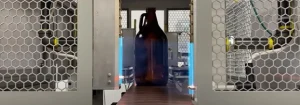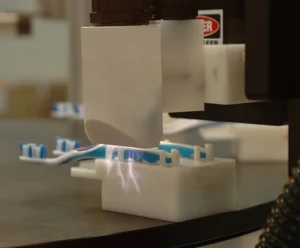By Mike Couch, VP engineering, INPRO Technologies Incorporated; Wilson Lee, business development manager, Enercon Industries Corporation; Mark Plantier, VP marketing, Enercon Industries Corporation
It would be hard to find an industry these days that doesn’t use plasma or flame for surface preparation. Some of the larger industries that rely on these surface-treating technologies include automotive, aerospace, window and door, assembly, medical, wire and cable, electronics, decorating, and packaging.
Plasma and flame are used to promote adhesion on a wide variety of surfaces. These reliable technologies are a top surface preparation choice for several reasons. They can replace hazardous adhesion-promoting chemicals and mechanical processes which are subject to human error. The repeatability of treatment ensures product quality and productivity can be increased. How these systems are integrated into existing lines is key to their success.
Determining the right technology for the application
Proving surface treating will work for a given application is relatively simple. Sample tests may be conducted in a laboratory such as Enercon’s. Several types of plasma and flame systems can be tested to see which ones will provide the treatment results desired. The technologies clean, etch and functionalize surfaces to enable bonding with inks, adhesives and coatings. Diagnostics can be run to measure surface energy, changes in polar groups, wettability and peel strength. Consignment systems can also be provided to field test an application in a customer’s plant.
In many cases, both flame and plasma will successfully provide the desired treatment results. The determining factor for which technology to use often comes down to how the system will be integrated in the field and by a calculation of area to be treated in a specific cycle time. This article addresses key considerations and best practices when integrating a plasma or flame surface-treating solution.
Fixed treatment heads with moving parts
In all applications, either the part moves, the treatment head moves or both move. Once it is decided how operators will implement surface treatment into their line, Enercon will provide guidance to the team and any integrators they may be working with. The simplest integration is when the surface of a flat object that is already part of a conveyance process is being treated. Photo 1 of the terminal block is a good example of this. The plasma head is mounted in a stationary position at a specific distance away from the parts. The parts are conveyed under the treatment head and then inkjet-printed right after treatment.

Other similar configurations could include the treater mounted underneath a conveyance system to enable printing of lot codes or as shown in Photo 2 of bottles being treated prior to decorating with two flame treating heads.
In some cases, parts are presented to a fixed treatment head via an indexing system or rotary table. Photo 3 shows a Blown arc™ system treating the handles of toothbrushes on a rotary table.

A relatively new technology in the automation industry is collaborative robots. The main benefit of a collaborative robot is that humans can work alongside it in an intrinsically safe manner.
Imagine a scenario where an operator is picking up parts and wiping them with a primer, and then putting them into a parts tray to load into a printer. It’s very easy to envision a collaborative robot working alongside operators to pick up parts out of a bin, move them on their way over to the parts tray underneath a fixed plasma treating head for treatment prior to printing.
Articulating treatment heads with fixed parts

For complex geometries, it is often simpler to articulate the treatment head around a fixed part. This can be done with simple XY or XYZ gantry systems, depending on what is needed. And, a robotic system can be used for truly limitless programming capabilities, as seen in Photo 4.
Robotics also offer the ability to use multiple tools in the same work cell. For example, you can use a treater head to prepare the surface and then the robot can swap tools to a dispensing head or print head, or even a UV curing head. This traditional robotic integration of the treatment head to treat a fixed part enables a huge amount of flexibility in geometries to be treated without the issue of determining how to robotically pick up or handle the part itself, which is especially beneficial if the part is already on some conveyance system in the process.
Mechanical, cable and controls integration
To minimize the number of connections, Enercon combines both electrical and air (gas for flame) connections into a single cable per treatment head. High flex cabling options are available for applications requiring repeated movement of the treatment head. Even with these special cables, it is important to manage cable movement in accordance with their ratings and avoid excessive and repeatable bending to ensure long-term operation.
Enercon offers stands that can be used to mount plasma and flame surface treatment heads over a production line and also offers an assortment of mounting collars for use when integrating with a robot or custom configuration. The important thing to remember is to maintain the proper distance between the treatment head(s) and the surface to ensure consistent treatment.
For flame treaters, both side-mount and top-mount burner configurations are available. For robotic applications, a high-velocity flame treatment head is available; when burners over 16″ in length are required, a water-cooled head is used. It’s important to define early on if propane or natural gas will be used to fuel the flame treater.
Follow local guidelines when plumbing the gas line. Consider that pipe dope is more permanent than Teflon. So, if there may be a reason to disassemble a joint in the future for serviceability, use the Teflon. Since a fully developed flow is less turbulent, aim for providing a laminar flow to the burner and avoid right-angle fittings at the burners wherever possible.
Enercon has developed its PRO Series to simplify integration. It’s capable of handling a wide range of incoming power and offers multiple network communication options: remote control and monitoring of stop/start, priming, on and off air flow, all with closed loop feedback. The system also uses artificial intelligence for troubleshooting and includes a USB available for downloading data and updating software.
Thermal management
Both plasma and flame surface treaters will generate heat so considerations for managing that heat are important. Components around the treatment heads should be protected and rated for the environment they will be used in. This could include conveyors, hoses, brackets and other elements.
Use a well-ventilated system to remove heat from the area and be sure to protect operators by using heat shields and safety guarding for areas they may come in contact with.
Additional considerations
Dirty power and large voltage fluctuations are other things to consider. If the facility is subject to large voltage fluctuations, operators may want to install a voltage transformer upstream to condition that power coming in. Fluctuations in voltage can result in inconsistent performance.
Summary
Plasma and flame surface treating can improve product quality, production consistency and throughput while reducing costs, eliminating hazardous primers and allowing for the reallocation of employees to higher-value functions. Today’s treatment technologies are versatile and integration ready. Following best practices and planning ahead with suppliers will ensure successful implementation of surface treating.
Enercon Industries Corporation is a family-owned business recognized as a global leader in corona, plasma and flame surface treating and induction cap sealing technologies. Enercon serves packagers, decorators, assemblers, converters and extruders in the food, beverage, pharmaceutical, consumer goods, flexible packaging, automotive, medical, electronics and plastics industries. Learn more at www.enerconind.com.
INPRO Technologies supplies, engineers and integrates automated and robotic solutions for UV, plasma, flame, web cleaning, case packing and palletizing applications. Learn more at www.inprotechnologies.com.


